
Tobias Nordhausen via Flickr
The Decline of the Political Center in Germany

Anton Eriksson
King's College London
Anton Eriksson is an undergraduate student at the Department of War Studies, King’s College London. Previously, he has spent time in Germany working with a political party during elections and interned at an ESG company working at the intersection between politics and climate change.

Jana Konle
King's College London
Jana Konle is an undergraduate studying Philosophy, Politics, and Economics at King’s College London. Previously, she worked as a Federal Volunteer for Amnesty International in Berlin. Her research interests include the link between descriptive and substantive representation of women in Parliament and the rise of Populism in Europe.

Malina Aniol
King's College London
Malina Aniol is a third-year undergraduate student at King’s College London, studying Philosophy, Politics, and Economics. Previously, she finished a Foundational Degree at Freie Universität Berlin. Besides her studies, she works as a Research Officer on Civic Education at the 89Initiative.

Nikki Shure
University College London
Nikki Shure is Associate Professor in Economics at the UCL Social Research Institute at University College London and a Research Affiliate at the Institute of Labor Economics (IZA). She completed her PhD in Economics as a Weidenfeld Scholar at the University of Oxford. Nikki is an Atlantik-Brücke Young Leader and previously held a Fulbright Scholarship to Germany.

Thomas Fröhlich
King's College London
Dr. Thomas Fröhlich is a DAAD/AICGS Research Fellow from September to November, 2021. Dr. Fröhlich currently holds a prestigious ESRC postdoctoral fellowship at the Department of War Studies at King's College London. His research examines the intersection between climate change mitigation, the global deployment of low-carbon energy, geopolitics, and international relations theory. His PhD analyzed Brazil's international ethanol strategy and its attempts to create a global market for biofuels. The related book will be published during his tenure at AICGS.
At AICGS, Dr. Fröhlich will work on a comparative study of the coal phase-out in West Virginia and the Lusatia region in Eastern Germany. The focus of this work is to better understand the local effects of this structural change and how to best support affected communities in overcoming the related hurdles. With the transatlantic knowledge exchange in mind, Dr. Fröhlich will collect a set of best practices and lessons learned to enable policy learning between the US and Germany.
The DAAD/AICGS Research Fellowship is supported by the DAAD with funds from the Federal Foreign Office.
Where Good Candidates Can Make a Difference
The 2021 elections of the German Bundestag will define the immediate post-Merkel era. In this project on German federal elections, we analyze the conditions for the rise of non-centrist political parties in Germany, especially the far-right Alternative für Deutschland (AfD). For this blog post, we identify the structural and economic factors that correlate with AfD success, identify “good candidates” and establish their rarity, and finally present three crucial constituencies where new good candidates might be necessary to defend the political center against looming AfD victories.
Introduction
Despite having been governed by a Grand Coalition under the leadership of the center-right Christian Democratic Union (CDU) for the past twelve of sixteen years, the traditional centrist parties in Germany, the CDU, her Bavarian sister party the Christian Social Union (CSU), and the center-left Social Democratic Party (SPD) have been under electoral pressure for quite some time. Figure 1 shows that the share of Erststimme (local representative vote) and Zweitstimme (party vote) received by these center parties has been in decline across successive federal elections. (For an overview of the German electoral system see this useful AGI publication.)
Figure 1: The decline of the center in German federal elections
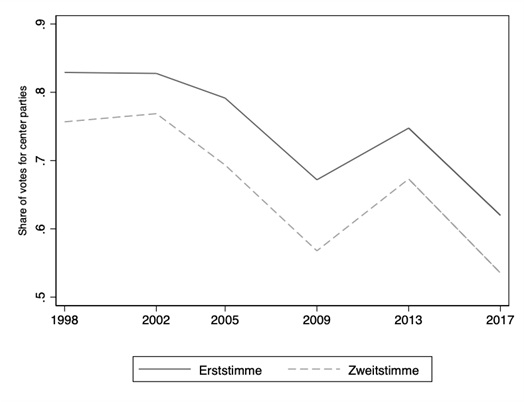
Notes: Data from Bundeswahlleiter (2021). Center parties includes CDU/CSU and SPD.
In this project, we aim to analyze and better understand the dynamics that drive the electoral decline of the political center in Germany, based on structural indicators rather than relying on often imprecise polling data. In this blog post, we discuss which structural and economic factors are related to the decline of the center, highlight the importance of “good candidates,” and give an outlook for the 2021 elections.
Background
The project started with the question of whether it would be possible to better understand the structural and material conditions that lead people to vote for non-centrist parties. In the past—particularly in the United States with the election of Trump and in the UK with the Brexit referendum—polling did not accurately predict these political shifts towards the fringes. The Cambridge Analytica scandal, conversely, showed that identifying (and shaping) voter preferences based on data about them and their surroundings does allow for very accurate voter intention forecasts. The question remained as to whether it was possible to identify measurable patterns that predict shifts away from the centrist vote.
This project’s approach
Initially, we conducted a review of the available political science literature as well as expert commentaries on the topic of the decline of the political center more broadly and internationally, as well as particularly in Germany with a focus on the question “who votes for the Alternative für Deutschland (AfD),” and finally literature on the responsiveness of party systems and determinants for electoral outcomes. In this literature review, we identified seven themes which we wanted to measure to see how large of an impact they had on voters: economic insecurity, immigration, age, disaffection with government, education level, east vs west, rural vs urban, and social cohesion.
In a parallel step, we prepared a dataset based on publicly available data by the Bundeswahlleiter that combined the results of federal elections from 1998-2017 with structural data on the constituency (Wahlkreis) level.
Based on the literature review, we compared the characteristics between constituencies that had been stable in their support of center parties and those that had been volatile. We also ran linear regression models to predict the share of votes going to center parties over time. This allowed us to verify assumptions—such as whether the decline of the center is associated with higher unemployment rates—and created our own proxy-variables to measure other factors identified in the literature, such as the “social conservativeness” of a constituency.
Limitations
The dataset used in this project only contains structural data of constituencies for the years 2013 and 2017. This limits our understanding of the predominant losses of the SPD from 1998, while it allows for a good understanding of the CDU losses that occurred more strongly from 2013. In this period, the AfD also entered the scene, with a first run on the national level in 2013 and clearing the 5 percent threshold and thereby entering the Bundestag for the first time in 2017. We did not control for the number of parties (and their respective positions) running, but rather focused on the parties that entered the Bundestag. And finally, our findings only show significant correlations, which require further qualitative research to better understand the mechanisms behind that. We do not claim to demonstrate causal relationships based on our data analysis.
Preliminary findings
Our initial finding was that indeed, the political center of Germany has suffered electoral losses over the observed period in all states. Our definition of the political center of Germany was informed by the ParlGov dataset. This database covers circa 1700 parties internationally and scores them on a 0 (left) to 10 (right) scale. For our purposes, we defined the political center as between 3 and 7.4 points. This range was chosen to include the SPD (3.6) on the left but also the CSU (7.3) on the right.
As already shown in Figure 1, the political center parties experienced an electoral decline in Germany between 1998 and 2017. Figure 2 shows that this mainly affected the SPD; the CDU/CSU only suffered losses in the range of two percentage points (Zweitstimmen) from 1998-2017. Importantly, nonetheless, both parties experienced a decline from 2013 onwards (the CDU/CSU lost 8.6 percentage points in Zweitstimmen from 2013 to 2017), which is why we continue to explore the decline of the center. This can also be seen from the absolute number of votes of the center parties, with the number of votes for the center parties decreasing from 37,510,657 votes, in the 1998 election to 24,856,725, in the 2017 election, which means they lost around a third of the number of votes during this period.
Figure 2: The decline of the CDU/CSU and SPD in German federal elections
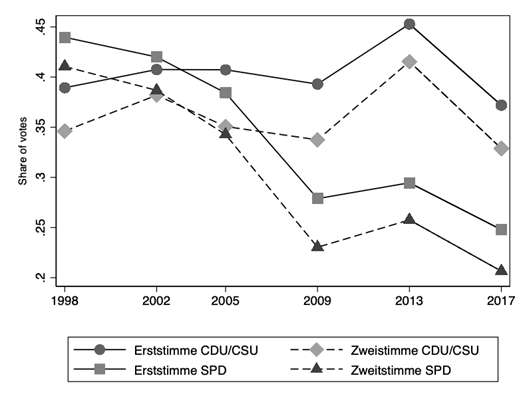
Notes: Data from Bundeswahlleiter (2021).
One question we faced during our research was whether to classify Bündnis 90/Die Grünen (Greens) as a centrist party or not. Rooted in the anti-nuclear and pacifist movement of the 1980s, the Greens certainly still cover non-centrist left positions. This tradition, however, has been watered down with the Greens’ participation in government, in particular by the rise in coalitions between the Greens and the CDU on the state level. While ParlGov ranks the Greens at 2.9 points, hence outside our definition of the center, we deemed it prudent to compare the decline of the center excluding and including the Greens.
Figure 3: The decline of the center with and without the Greens
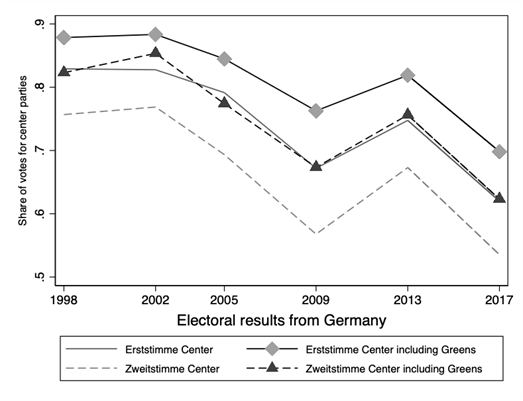
Notes: Data from Bundeswahlleiter (2021). Center parties include either CDU/CSU and SPD or CDU/CSU, SPD, and Greens.
When including the Greens into the center parties in Figure 3, the decline is still existent, but the levels are higher, suggesting that it was not only a centrist Green party that absorbed the electorate but rather that parties on the fringes gained as well. In terms of government stability, this could be one explanation for the need for a Grand Coalition throughout the past eight years.
Volatility of center parties’ vote share
We then turned our attention to the drivers of this decline. To do this, we identified districts that were particularly “volatile” or “stable” in the share of votes cast for the center over the period 1998-2017. Here a volatile district is one in the top quartile of all changes in the vote share going to the center, irrespective of a negative or positive change (only two constituencies experienced an increase in the share of center votes from 1998-2017). These are the districts that experienced big changes in the share of votes going to the center. Stability is therefore classified by changes in the bottom quartile of the distribution of all changes, again positive or negative. Stability therefore means continuity in the share of votes going to the center. These are the districts with very little change in the share of votes going to the center.
We compare the structural indicators of volatile and stable districts in Figure 4. The up arrow shows factors that are higher on average in volatile districts as compared to stable ones and the down arrow show factors that are on average lower in volatile districts as compared to stable ones. This shows, for example, that volatile districts have higher GDP per capita than stable ones. One example of a highly volatile constituency is Berlin-Reinickendorf, which has a higher-than-average GDP per capita and experienced a 29.3 percent swing to non-centrist parties in the Erststimme with an even greater 28.2 percent swing to non-centrist parties in the Zweitstimme from 1998-2017.
Figure 4 also shows that stable districts tend to be wealthier, when measured by home ownership, and better educated (these averages are lower in volatile districts as compared to stable ones). One example of a very stable, centrist constituency is St. Wendel, in the Saarland, which only lost 0.5 percent of its centrist vote from 1998-2017, the smallest change in all of Germany, and is a constituency characterized by economic prosperity and a more educated population.
Figure 4: Comparing the characteristics of volatile with stable districts
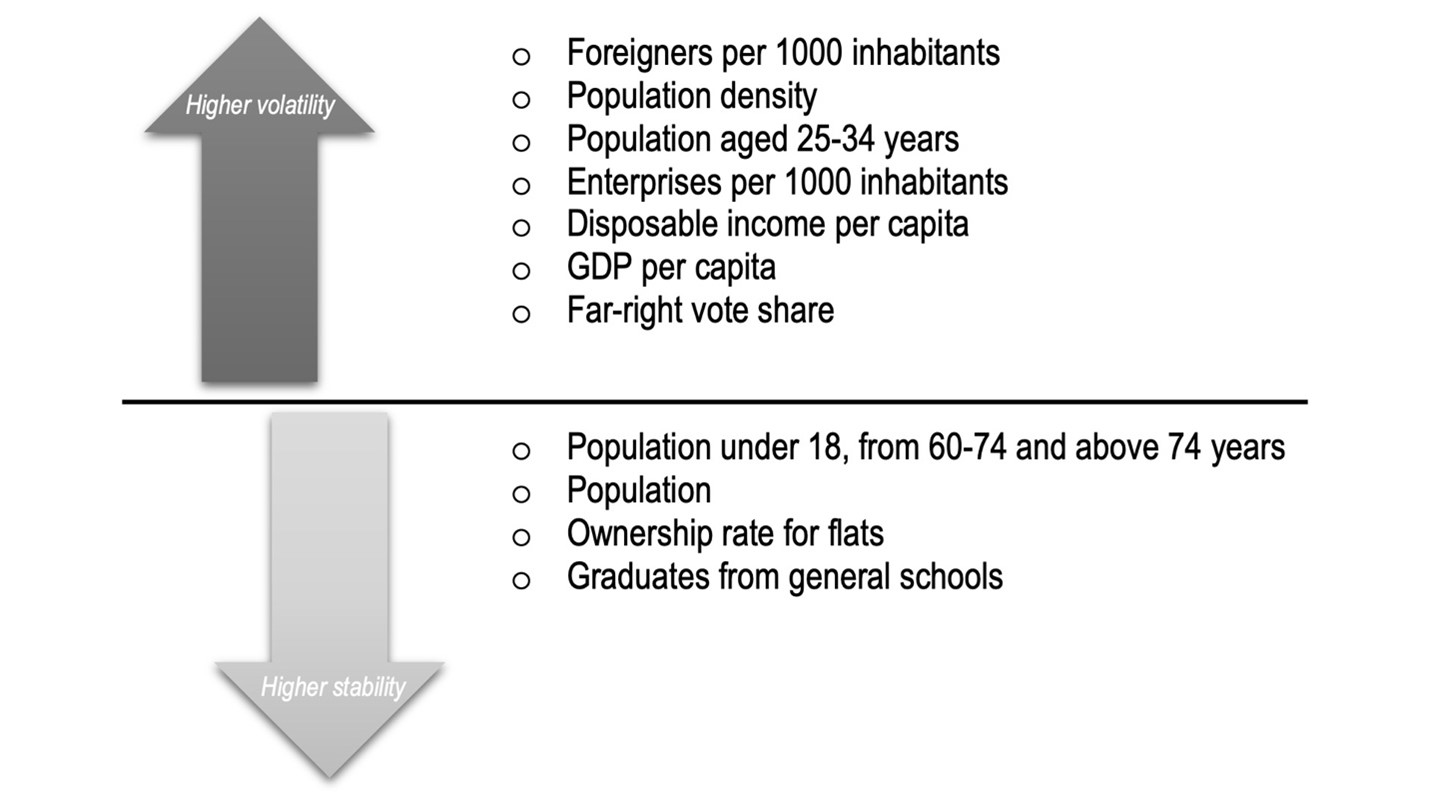
Notes: Data from Bundeswahlleiter (2021). Districts in the top 25% of volatility are compared with districts in the bottom 25% of volatility. The up arrow refers to a higher mean for volatile districts as compared to stable districts. The down arrow refers to a lower mean for volatile districts as compared to stable districts. These factors were compared using a t-test across groups and found to be statistically significant at the 5% significance level.
The role of “good candidates”
While there seem to be some structural differences between stable and volatile constituencies, we wanted to dig deeper into the role of the candidate. Inspired by a paper by Joshua Kalla and David Broockman[1] on the effects of campaigning, which claimed that door-to-door campaigns did not deliver measurable results without considering the quality of a candidate, we decided to further examine the role of “good candidates,” taking a data-driven approach.
We defined a good candidate as a person who won the Direktmandat, the highest share of Erstimme, in a constituency, where their party did not gain the highest share of Zweitstimme votes.
Based on this definition, we identified such victories in 97 out of 299 constituencies over the period from 1998 until 2017, proving the rarity of this occurrence. In 2017, a total of 35 good candidates won their respective constituency (the complete list can be accessed here).
Certain constituencies thus are distinctly drawn to good candidates albeit their party not being particularly popular. Good candidates can be found along the political spectrum. Interestingly, it appears that in specific cases, good candidacies can be passed on to the next generation, when one person involved has a high degree of name recognition (e.g. Hans-Christian Ströbele passing his constituency to fellow Green Canan Bayram), but again this is a rare phenomenon.
We also found that only three good candidates (Dr. Matthias Bartke, SPD; Dr. Fritz Felgentreu, SPD; and Mathias Stein, SPD) are in constituencies that have been particularly volatile for center parties over the period 1998-2017. This implies that good candidates are more likely to arise in constituencies where center parties have not experienced a large decline. It is also not the case that they only occur in stable constituencies (this also only happened three times). Instead, there needs to be some degree of movement in the center vote share for good candidates to emerge.
Table 1: “Good candidates” in Bundestag elections 2017 in stable and volatile constituencies
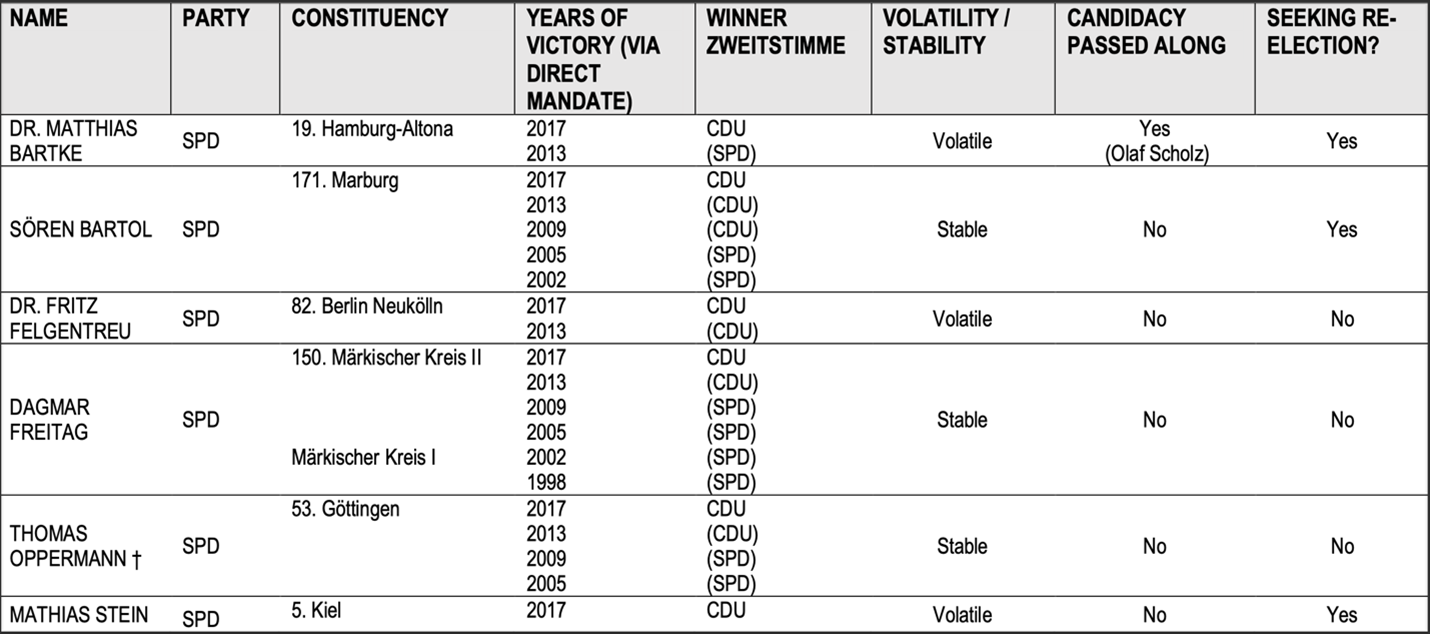
Notes: Data from Bundeswahlleiter (2021). Constituencies are classified as ‘volatile’ if the change in share of the center vote is in the top 25% of all changes from 1998-2017. Constituencies are classified as ‘stable’ if the change in share of the center vote is in the bottom 25% of all changes from 1998-2017.
Looking at the list of good candidates, we can see that they are predominately SPD members, usually winning against the CDU who got the most votes in the Zweitstimme, whereas the CDU candidates outperform the AfD. This primarily suggests that these good candidates have been successful at convincing supporters to vote for them over the supposed winning party (tactical voting). Furthermore, most of these good candidates are high profile and have either been in the party for a long time before running for Bundestag or were part of the Landtag. Therefore, they have big-name recognition and are able to capture voters through these means as well.
The list of constituencies with good candidates shows that they are mainly in cities, such as Hamburg, Berlin, or Dresden, or are in rural Eastern Germany, where the AfD is heavily present. On average, districts where good candidates won can be characterized as socio-economically well off, as they have a seven percentage points higher share of people graduating with a high school diploma and the annual GDP per capita is more than 5000 Euros higher compared to the mean in other districts. While the demographic structure is similar to the national average, the populations in these constituencies are slightly younger. A stark contrast is the share of Catholics in constituencies, which is 17 percentage points lower in districts won by a good candidate than on average. This finding is surprising as many of the constituencies were won by the CDU in the Zweitstimme and Catholics are seen as one of their main support groups.
What does that mean for the 2021 elections?
The preliminary findings of this project suggest that there has been a decline of the political center in Germany between 1998 and 2017 across almost all constituencies. This is not only driven by the poor performance of one center party, nor is it reduced by the expansion of the center to include the Greens. Importantly, the districts that have experienced the biggest changes in the share of the center are different from those districts that have been relatively stable when measured using structural data. Stable districts have older, wealthier, and better-educated voters. For the 2021 election, these stable districts will likely continue to support the center.
Given the decline of the center, it is interesting to focus on those candidates who outperform their party. In the 2021 election, there will be twelve districts in which the good candidates who won in 2017 will not run for re-election. These are races to watch since the good candidate will be missing as a stabilizing factor for the center vote share.
Among these, three district battles, Dresden II – Bautzen II, Cottbus – Spree-Neiße and Meißen, will be of particular interest since in 2017 the Zweitstimme in these districts was won by the populist right-wing AfD, but the respective good candidate who won them from the CDU is not seeking re-election. It will be interesting to see whether the three districts whose good candidates are no longer running will join the list of Eastern German districts with a right-wing direct candidate (currently three).
There is reason to think that the AfD will prevail. Analyzing the structural factors within these constituencies, we find that the age, migration, unemployment, and educational structure are very similar to the constituencies that the AfD won outright in 2017. Given the rarity of passing on constituencies from one good candidate to another, it may be difficult for another CDU candidate to fill this void. That being said, none of these three constituencies are classified as highly volatile in the performance of the center from 1998-2017, which leaves a chance that the center prevails.
This project was generously funded by King’s College London’s “King’s Undergraduate Research Fellowship (KURF)” Program. We also acknowledge funding by the Economic and Social Research Council (ESRC grant reference: ES/T00892X/1).
[1] Kalla, J. L., & Broockman, D. E. (2018). The minimal persuasive effects of campaign contact in general elections: Evidence from 49 field experiments. American Political Science Review, 112(1), 148-166.









